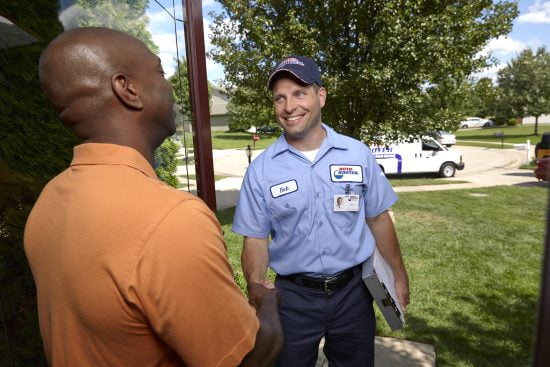Pipe Repair
Pipe Descaling
The formation of scale can impede the flow of water from your home, preventing your appliances from draining properly. By working with a licensed Roto-Rooter professional plumber, these issues can be avoided with our pipe leak repair and descaling services. Over time, debris and wastewater can form a hardened coating known in the plumbing industry as “scale”. It is common for cast-iron drain pipes to rust over time and create flaky residues that occupy the inner drain flow space.
What Is Pipe Descaling & Rehabilitation?

Pipe descaling entails the use of water pressure and a series of mechanical brushes to grind away and remove hardened debris from sewer and drain pipes. This technique will restore the normal flow of water throughout your home and allow your plumbing systems to drain properly. Pipe descaling services typically utilize a flexible shaft with a brush head, inserted into the scaled pipe, that scrapes away the scales. It is then followed up with high water pressure to remove the debris and restore your pipe to a smooth condition.
Impacts Of Scale Within Your Pipes
Without pipe descaling, your home could be seriously and adversely impacted. Perhaps most importantly, the flow of water to and from your faucets and drains will be impeded, leading to pooling water and backups. In addition, the corrosive nature of the scales will damage the longevity of your plumbing systems. Overall, the presence of scale in your plumbing system will have an adverse impact to the structure of your home. You can often find pipes that need to be descaled through routine video inspections of your underlying plumbing system.
Process And Details
A cable shaft with a series of mechanical scrapers spins at high speed therefore creating friction that files and scrapes the rust and scale off the pipes. The machine has a high torque capability and its speed can be varied depending on the job at hand. A constant high-pressure stream of water flushes rust debris that falls to the bottom of the pipe. This procedure opens the pipe for better flow. As a result of the removal of scales, the old cast-iron pipe resembles a new one in its look, flow, and functionality.
The descaling process starts from front to back. The brush begins at the end of the drain system and continues upward toward the opening. Descaling can be a tedious process of filing the clog-creating obstructions, hydro-jetting the loose scales, and video inspecting to ensure quality work. Therefore, descaling takes patience and care and if performed correctly should be time-consuming.
Benefits
Cast-iron pipes show signs of excessive scale build-up after daily use for about 35-50 years. Implementation of a thorough pipe rehabilitation process adds another 35-50 years of use if there are no structural damages to the original pipes. Therefore, descaling extends the life of drain pipes and helps homeowners avoid a costly drain replacement. Pipeline rehabilitation eliminates those flaky obstructions that trap deposits so the pipe functions correctly. In conclusion, it creates a minimal opportunity for a clogged drain pipe.